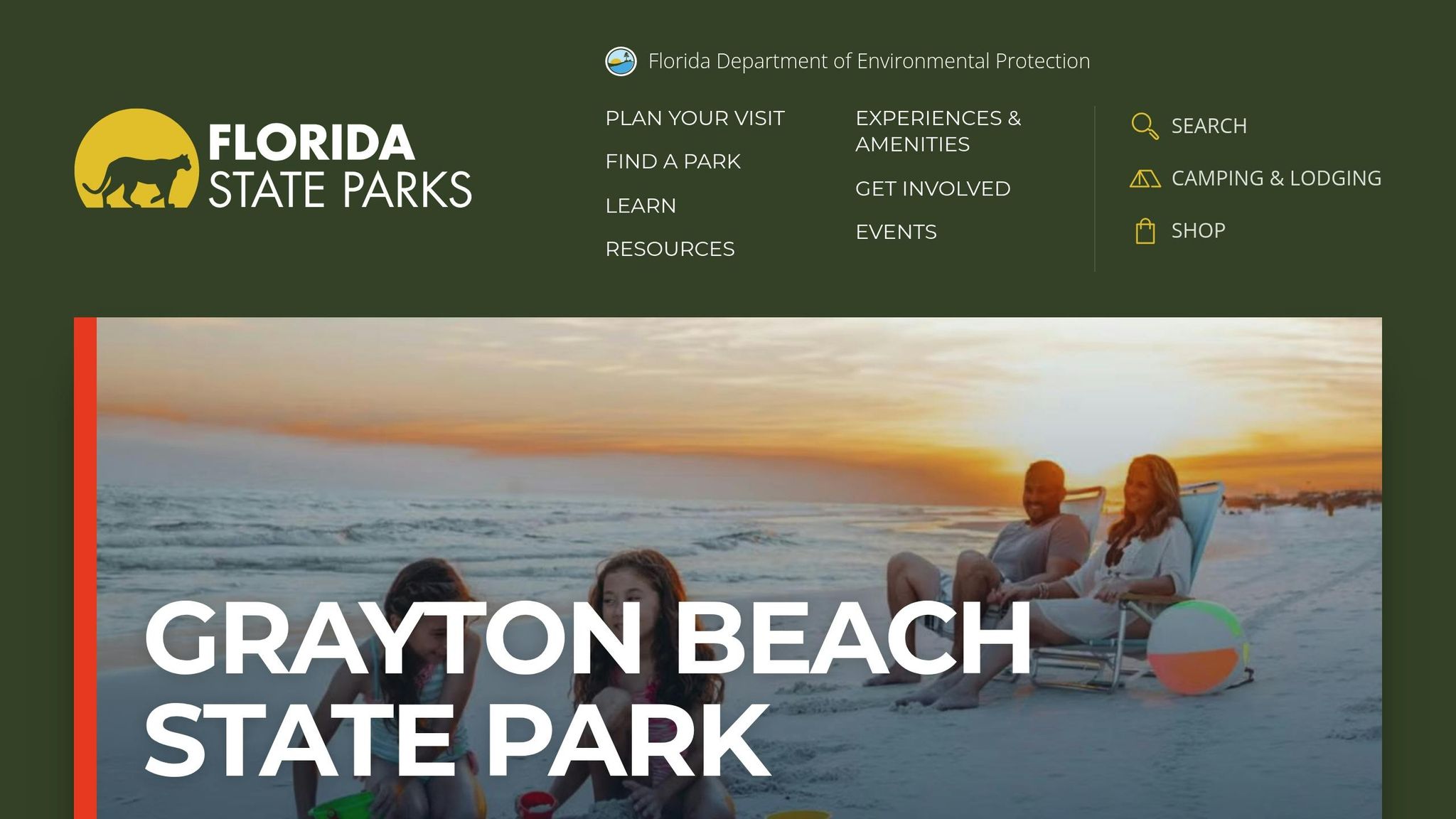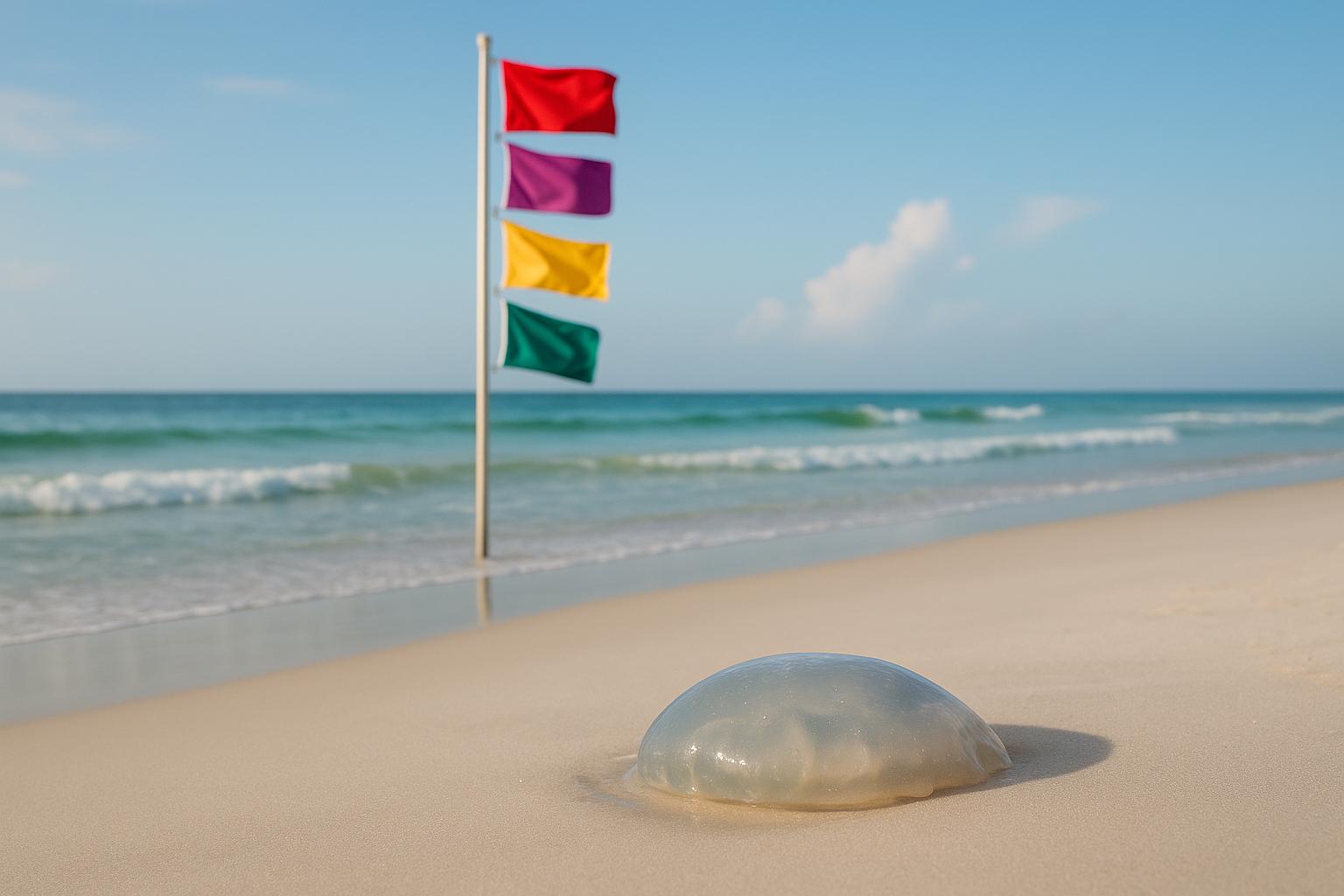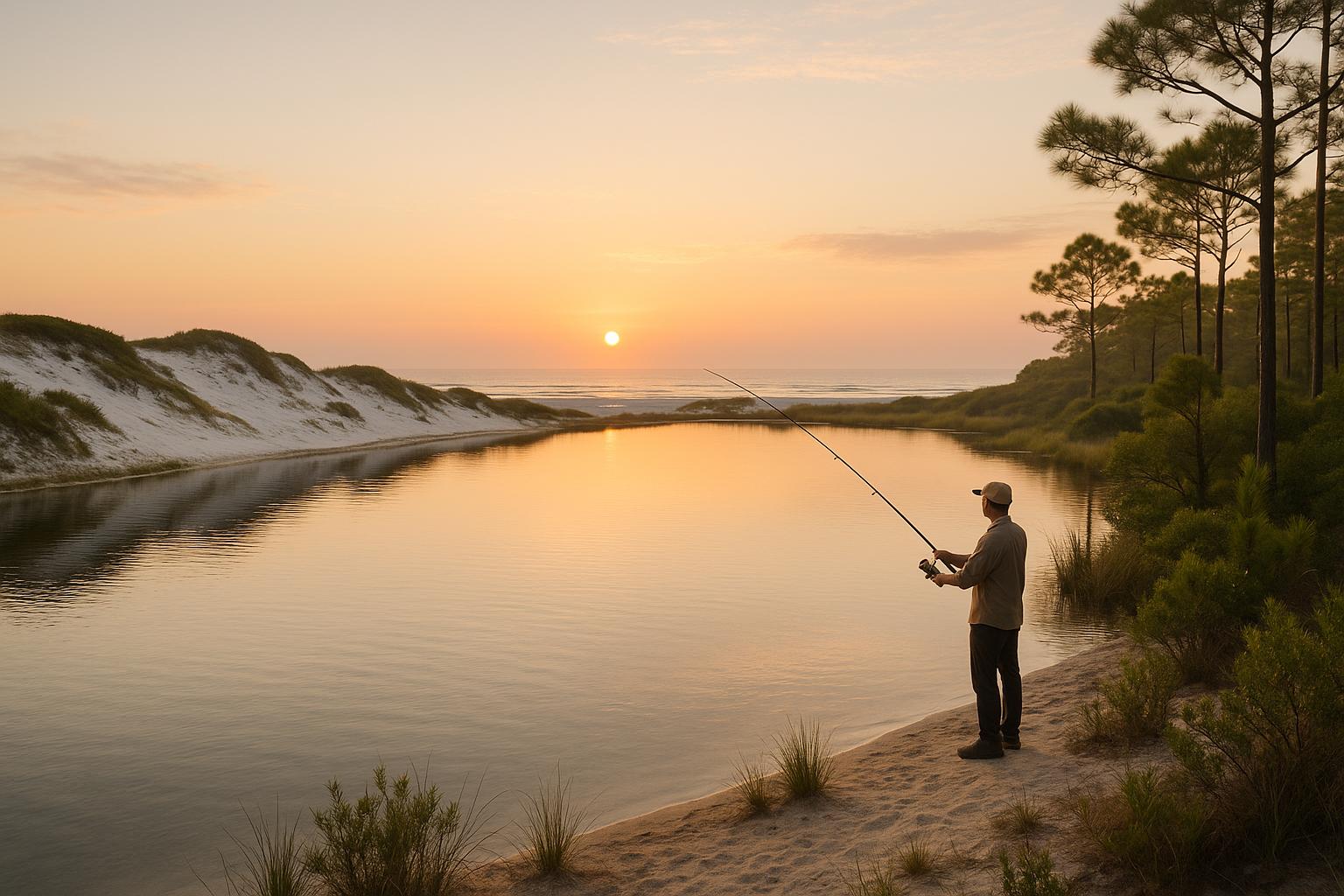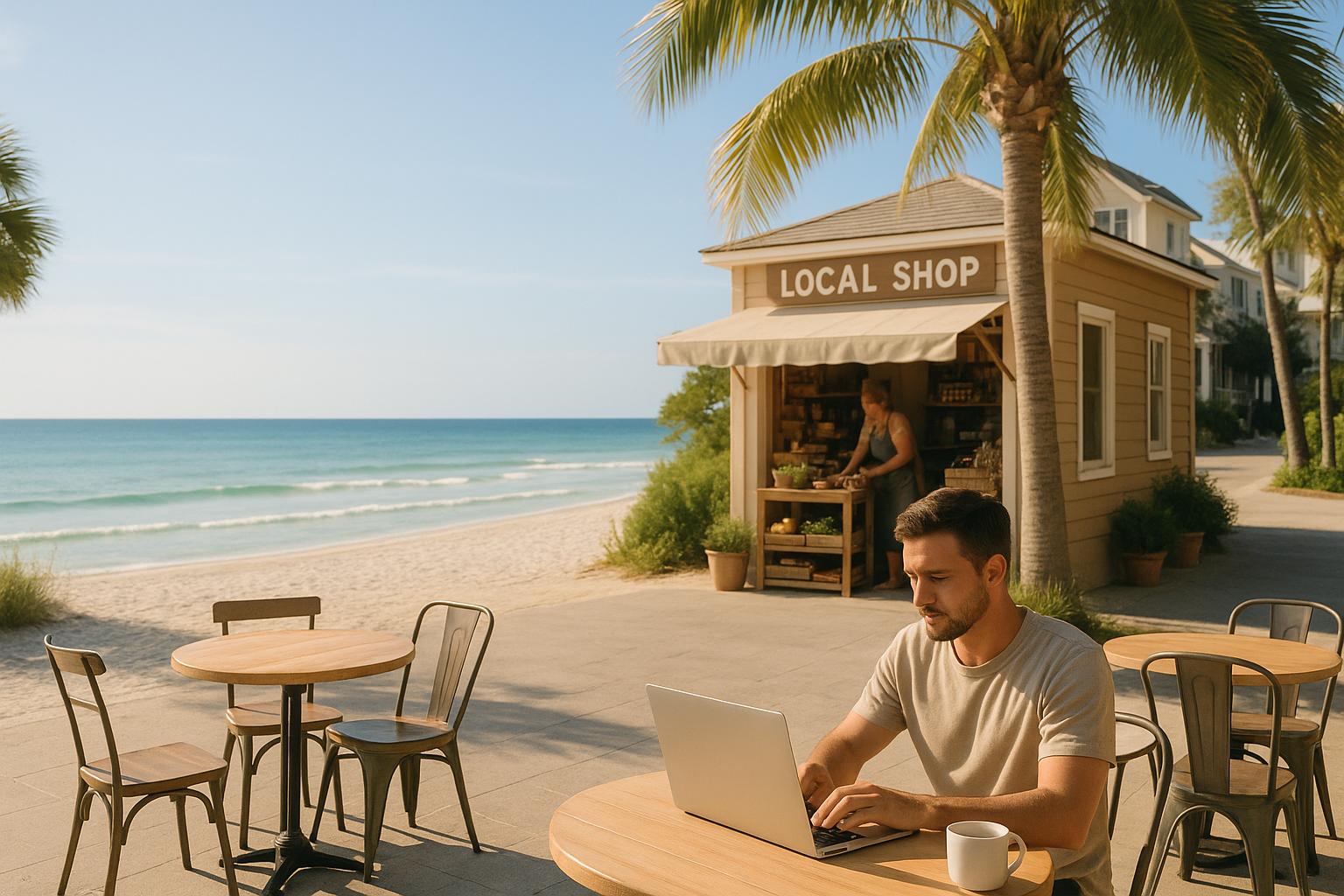Paddleboarding on 30A offers two great options: calm coastal dune lakes and the Gulf of Mexico's lively waters. To make the most of your adventure, timing is key. Here's what you need to know:
- Spring (March–May): Ideal weather with temperatures from 69–82°F and manageable humidity. Perfect for long paddles and Gulf swims.
- Summer (June–August): Warm Gulf waters, great for swimming, but stick to early mornings or late afternoons to avoid the heat.
- Fall (September–November): Comfortable temperatures, fewer crowds, and stunning sunsets make this a favorite season.
- Winter (December–February): Quiet and peaceful, but dress for cooler conditions.
Best Times of Day:
- Early Morning (before 10 a.m.): Calm, glassy waters, cooler temps, and fewer crowds.
- Late Afternoon/Golden Hour: Cooler, scenic sunsets, and relaxing conditions.
- Midday: Stronger winds, choppier waters, and higher sun exposure - best avoided unless well-prepared.
Key Tips:
- Watch for changing weather and tides.
- Use tide charts to plan easier launches.
- Protect yourself with sunscreen, hydration, and safety gear.
Whether you’re exploring the serene coastal dune lakes or tackling the Gulf, 30A has something for every paddler.
Grayton Beach State Park | Paddle Boarding Florida | Winter on 30A

Best Seasons for Paddleboarding on 30A
Every season on 30A brings its own charm for paddleboarding, with unique conditions that cater to different preferences.
Spring (March–May)
Spring is hands-down one of the best times for paddleboarding on 30A. The weather gradually warms up, with average highs climbing from 69°F in March to a comfortable 82°F by May. By April and May, temperatures typically settle in the mid-70s to low 80s, making it perfect for longer paddling adventures. Plus, the humidity levels are still manageable compared to the summer months. Around mid-spring, the Gulf waters also warm up enough to enjoy a swim during or after your paddleboarding session.
Summer (June–August)
Summer brings the heat, which many paddleboarders love. The Gulf waters are at their warmest, creating ideal conditions for those who enjoy a refreshing dip while paddling. Just be sure to plan your outings during the cooler parts of the day, like early morning or late afternoon, to avoid the peak sun.
Fall (September–November)
Fall is another fantastic time to hit the water. As the summer heat fades, temperatures become more moderate, offering a comfortable setting for paddleboarding. The quieter beaches and stunning fall sunsets add to the experience, making this season a favorite for many.
Winter (December–February)
For those seeking solitude, winter is perfect. The cooler air and water temperatures mean fewer crowds, giving you a peaceful paddleboarding experience. However, it’s essential to dress appropriately for the chill and keep an eye on weather updates to ensure safe conditions.
Weather patterns can change throughout the year, so keeping an eye on local forecasts will help you make the most of your paddleboarding adventures. Up next, discover the best times of day to maximize your experience on 30A.
Best Times of Day for Paddleboarding
When it comes to paddleboarding on 30A, the time of day can make or break your experience. Factors like water conditions, sun intensity, and crowd levels shift throughout the day, so timing is key. Here's a closer look at the best times to hit the water.
Early Morning
Paddleboarding in the early morning is hard to beat. The water is typically calm and glassy, offering a serene and peaceful experience. Heading out before 10:00 a.m., especially during summer, helps you avoid stronger winds and the risk of afternoon thunderstorms.
"Go early in the morning when the water is glassy." - Destin Dreamers
This time of day is also perfect for spotting wildlife and enjoying cooler temperatures. Beginners will appreciate the forgiving conditions, especially in sheltered spots like coastal dune lakes. These calm, quiet mornings are a great match for the spring and fall climates mentioned earlier.
Late Afternoon/Golden Hour
If mornings aren’t your thing, late afternoon - particularly the golden hour before sunset - offers its own magic. As midday winds ease, the water becomes calmer, though not as still as in the morning. The sunset adds a stunning backdrop, and the cooler temperatures make for a more enjoyable outing.
"I always recommend going in the afternoon. Bring dinner and drinks and catch the sunset. It's also not nearly as hot, and your sunburned self will thank me later for this little piece of advice." - Our Little Lifestyle
This time is ideal for those looking to unwind after a busy day or for couples seeking a romantic paddleboarding experience. While the water might not be as calm as in the morning, the atmosphere more than makes up for it.
Midday
Midday paddleboarding, between 10:00 a.m. and 2:00 p.m., comes with its fair share of challenges. Stronger winds, choppier waters, and intense sun exposure can make this time less appealing. Risks like sunburn, dehydration, and heat exhaustion are higher during these hours . Winds often exceed 15 mph, adding another layer of difficulty.
Crowds are another factor to consider. This is peak beach time, meaning more boat traffic and busier waters.
"The main thing to expect is busy beaches. You want to be on the beach from 10 am-2 pm and in the front row. Well, so does everyone else!" - Our Little Lifestyle
If you do venture out midday, stick to sheltered areas, slather on sunscreen, and stay hydrated to make the most of it.
sbb-itb-d06eda6
Weather, Tides, and Safety
Weather, tides, and safety protocols play a major role in shaping your paddleboarding experience on 30A. This guide expands on earlier tips, offering practical advice to help you navigate the area’s ever-changing conditions.
Weather Conditions
When it comes to paddleboarding, wind patterns are your top weather concern. Mornings tend to be the calmest, with winds staying below 10 mph, while afternoons often bring stronger gusts, reaching 15-20 mph or more. Offshore winds (blowing from land to sea) create smoother waters, ideal for paddling, while onshore winds (blowing from sea to land) stir up choppier conditions that even seasoned paddlers might find challenging.
Temperature is another factor to keep in mind, both for comfort and safety. Summer mornings usually hover around 75°F, but afternoons can climb past 95°F, increasing your risk of heat exhaustion and dehydration. In winter, mornings can start as low as the 40s before warming into the 60s or 70s by the afternoon, which means layering appropriately is key.
Thunderstorms are a serious threat, particularly during the summer months (June through September). These storms often develop in the afternoons, typically between 2:00 and 6:00 p.m., bringing lightning, heavy rain, and sudden gusts. Keeping an eye on weather radar throughout the day is essential.
Seasonal weather patterns also influence your plans. Spring can be unpredictable, with occasional cold fronts, while summer brings steady heat but frequent storms. Fall offers some of the most stable conditions, and winter can surprise you with abrupt temperature drops when cold fronts roll in.
But weather isn’t the only thing to consider - tides also have a big impact on your paddleboarding experience.
Tides and Their Impact
Understanding tide timing is crucial, especially when launching from beach access points or exploring coastal dune lakes. High tide makes beach launches easier by bringing the water closer to parking areas, while low tide might leave you trekking through shallow water or mud to reach deeper areas.
Tidal flow in the coastal dune lakes creates unique paddling conditions. When the tide is coming in, water flows from the Gulf into the lakes, often bringing clearer water and more marine life. Outgoing tides, on the other hand, can create stronger currents near lake outlets, which can be tricky for beginners to navigate.
Current strength changes with the tides. Spring tides - occurring during new and full moons - bring stronger currents and more dramatic water level changes. Neap tides, which happen during quarter moons, offer gentler conditions, making them a better choice for less experienced paddlers.
Launch timing becomes especially important during extreme low tides. At spots like Western Lake or Camp Creek Lake, low tide may leave areas too shallow for paddling, forcing you to carry your board farther or find another launch point. Checking tide charts at least a day in advance can save you from unnecessary hassle.
These environmental factors make it clear that safety should always be a priority.
Safety Tips
Sun protection is more than just slapping on sunscreen. The water’s surface reflects sunlight, increasing UV exposure. Wearing UPF-rated clothing, a wide-brimmed hat, and polarized sunglasses can provide better protection than sunscreen alone. Even so, apply SPF 30+ sunscreen and reapply every two hours, even if it’s cloudy.
Hydration is critical in Florida’s heat and humidity. Bring 16–20 ounces of water for every hour you plan to paddle, and for longer outings, consider adding sports drinks to replenish electrolytes.
Weather monitoring shouldn’t stop once you’re on the water. Use offline weather radar apps, and have a plan to return to shore quickly if conditions worsen. Remember, lightning can strike up to 10 miles away from a storm, so head to shore at the first sound of thunder.
Emergency preparedness is a must. Always carry a whistle, wear a properly fitted life jacket, and inform someone of your route and expected return time. Cell phone coverage can be unreliable in some areas along 30A, so don’t rely solely on your phone for emergencies.
Assess conditions continuously while paddling. If the wind picks up beyond your comfort level, waves start breaking over your board, or you feel fatigued, head back to shore immediately. It’s always better to cut your session short than to risk getting caught in worsening conditions.
Top Paddleboarding Spots on 30A
If you're ready to hit the water, 30A offers two distinct paddleboarding experiences: the tranquil coastal dune lakes and the open Gulf of Mexico. Each setting caters to different skill levels and preferences, providing something special for everyone. Here's a closer look at what makes these spots stand out.
Coastal Dune Lakes (Western Lake, Camp Creek Lake, Eastern Lake)
The coastal dune lakes along 30A are a haven for paddleboarders, thanks to their calm, protected waters. These rare freshwater lakes, located just behind the dunes, naturally connect to the Gulf, creating a unique paddling environment.
Western Lake at Grayton Beach State Park is a favorite among locals and visitors. Its glassy waters are perfect for beginners, offering a peaceful ride through scenic surroundings. Picture yourself paddling past tall pines, marsh grasses, and abundant wildlife. If you venture toward the Gulf entrance, you'll be treated to a stunning view where the lake meets the sea [4, 8].
Camp Creek Lake, nestled between Seacrest Beach and Watersound, provides a quieter, more secluded experience. With crystal-clear water and minimal crowds, it's ideal for early-morning paddles when the lake is at its calmest. The serene atmosphere makes it a great spot for nature enthusiasts.
Eastern Lake, located between Seagrove Beach and Watersound, is another standout. Known for its smooth, protected waters, it's a favorite for those seeking a laid-back paddle. The lake's picturesque setting is perfect for snapping photos, so don't forget your waterproof camera [4, 8].
These lakes are a fantastic choice for beginners, offering consistent, flat conditions even when the Gulf is choppy. With fewer people around, they also provide a more relaxed paddling experience [4, 14].
Gulf of Mexico
For those seeking a bit more adventure, paddleboarding on the Gulf of Mexico delivers. On calm days, the Gulf's waters can be as smooth as glass, offering a ride that's both scenic and exhilarating - something the lakes can't quite replicate.
Seaside Beach is a top pick for experienced paddlers. The stunning views of pastel-colored cottages along the shore add a charming backdrop to your paddleboarding session.
Blue Mountain Beach is another spot best suited for seasoned paddlers. Its open-sea conditions make for a thrilling ride, but they also demand more skill and preparation.
Before heading out on the Gulf, it's crucial to check wind and surf conditions. Mornings are typically the calmest, while afternoons can bring stronger winds. Always pay attention to the beach flag system - a red flag means it's unsafe to paddle [4, 14, 15, 16]. If you're new to ocean paddleboarding, consider taking a lesson to learn the basics and build confidence in navigating the changing conditions [14, 16].
Whether you prefer the calm waters of the lakes or the adventurous waves of the Gulf, 30A has a paddleboarding spot that's just right for you.
Planning Your 30A Paddleboarding Trip
Planning a paddleboarding trip along 30A means finding the perfect spot that matches your skill level and choosing the right time to hit the water. One of the area’s standout features is its thirteen rare coastal dune lakes, a natural phenomenon found in only a handful of places worldwide. These peaceful, scenic lakes are perfect for a relaxing paddle, while the emerald waters of the Gulf of Mexico offer a more adventurous option for those up for a challenge.
The coastal dune lakes are an excellent choice for beginners and families. Western Lake at Grayton Beach State Park is known for its calm, easy-to-navigate waters. Eastern Lake offers a serene escape, while Camp Creek Lake boasts crystal-clear water and an abundance of wildlife. Campbell Lake, located in Topsail Hill Preserve, is another family-friendly option with shallow and calm waters, making it safe for kids, adults, and even pets.
For experienced paddlers looking to up the ante, the Gulf of Mexico offers a thrilling alternative. On calm days, the Gulf’s waters provide a whole new level of excitement. Seaside Gulf Access offers stunning views, including the iconic pastel cottages dotting the shoreline. Blue Mountain Beach is another favorite, delivering that open-ocean feel many paddlers seek. But before heading out, always check the wind and surf conditions, and follow the beach flag system - remember, a red flag means no paddleboarding in the Gulf.
Timing your trip can make all the difference. Spring and fall bring mild temperatures and fewer crowds, creating ideal conditions for a peaceful paddle. Summer, while warmer, is manageable if you start early to avoid stronger afternoon winds.
Safety should always come first. Wear a life jacket, no matter how calm the waters seem or how strong a swimmer you are. Many local rental shops not only provide paddleboards and safety gear but also share helpful tips on the best launch spots and conditions. Their advice can be invaluable for ensuring a smooth and enjoyable outing.
Whether you’re drawn to the serene, wildlife-filled coastal dune lakes or the invigorating waters of the Gulf, 30A has something special for every paddleboarder. For more insider tips on where to launch and current conditions, check out sowal.co.
FAQs
What safety tips should I follow when paddleboarding on 30A throughout the year?
Safety should always be your top priority when paddleboarding on 30A. The precautions you take can depend on the season and weather, so it’s crucial to check the local forecast before heading out. This is especially important during the summer and hurricane season when strong winds or storms can create dangerous conditions. For the best experience, try to paddle during slack tide - about two hours before or after high or low tide - when the water is calmer and easier to navigate.
Make sure to wear a U.S. Coast Guard-approved life jacket, and always use a leash to stay attached to your board. It’s also important to stay within your skill level and be mindful of tidal currents, particularly in estuaries or rivers where they can be stronger. Keeping an eye on your surroundings and knowing your limits can go a long way in ensuring a safe and enjoyable paddleboarding adventure on 30A.
How do tides impact paddleboarding on the coastal dune lakes and the Gulf along 30A?
Tides play an important role in shaping paddleboarding conditions across 30A’s coastal dune lakes and the Gulf of Mexico. When the tide comes in, saltwater flows into the lakes, altering the salinity and water clarity. This shift can influence your paddleboarding experience, from the way the water feels to how much of the underwater world you can see. On the flip side, low tides may reveal more of the shoreline, opening up new areas to explore.
Tidal changes, along with storm surges, create a mix of conditions - sometimes calm and inviting, other times more demanding. Seasonal weather patterns, including storms and hurricanes, can also have a big impact on water flow and overall safety. To get the most out of your paddleboarding adventure, it’s smart to check local tide charts and weather updates beforehand. Staying informed helps ensure a fun and safe day on the water.
What’s the difference between paddleboarding on 30A’s coastal dune lakes and the Gulf of Mexico?
Paddleboarding on 30A’s coastal dune lakes offers a calm and tranquil setting, making it an excellent choice for beginners or anyone craving a peaceful outing. These lakes, naturally tucked behind sand dunes, are shielded from the effects of tides and weather. This creates a safe and serene environment where you can paddle without worrying about strong currents or waves.
If you're after a bit more excitement, the Gulf of Mexico provides a completely different paddleboarding experience. Here, you'll encounter saltwater, waves, and shifting tides that add an extra layer of challenge. It's perfect for seasoned paddleboarders looking to test their skills while soaking in the stunning views of the coastline.
Whether you’re drawn to the gentle waters of the dune lakes or the lively adventure of the Gulf, 30A caters to every paddleboarding preference.



